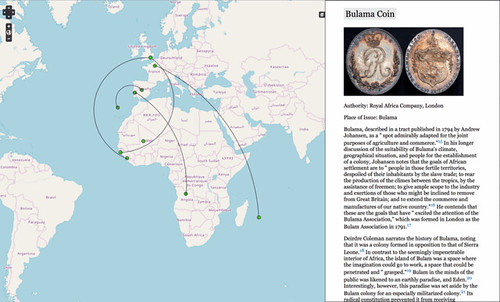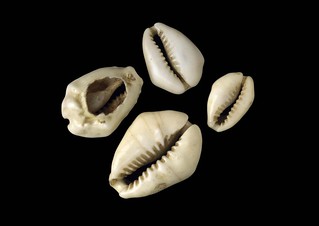
PREV ARTICLE
NEXT ARTICLE
FULL ISSUE
PREV FULL ISSUE
VISUALIZING SARAH SOPHIA BANKS' AFRICAN COINSEarlier this year Erica Y. Hayes and Kacie L. Wills published this article about their project, Visualizing Sarah Sophia Banks' African Coins, where they examine how the famous collector assembled, organized and thought about her collection. Here's an excerpt - see the complete article online. -Editor
While her brother's collections focused on specimens of natural history, Sarah Sophia collected printed ephemera and contemporary coins, tokens, and medals from around the world. Her collections, amassing to more than 30,000 objects, were presented to the British Museum upon her death in September, 1818, by Sir Joseph's wife, Lady Dorothea Banks. After working through her sizable collections, the curators at the British Museum donated 2,000 out of the 9,000 combined coins, medals, and tokens to the Royal Mint Museum, and a portion of her books and printed ephemera to the British Library. Although there are direct parallels between the collections of brother and sister, there has been very little analysis done on the connections between their collections. As Anthony Pincott has noted, the "interwoven" lives of brother and sister makes their shared lives, interests, and collecting activities difficult to unravel and analyze together. Sarah Sophia's sizable collections, in particular, have only been noted occasionally and, with the exception of the scholarship by Arlene Leis and Catherine Eagleton, little research has been done on them. The size and dispersed nature of Sarah Sophia's collection makes it challenging to study. Eagleton notes that "one of the biggest challenges scholars face studying Sarah Sophia Banks' is the quantity of the material—more than 9,000 coins and medals, and 19,000 prints". Our digital project, Exploring the Collections of Sarah Sophia Banks, focuses on two aspects of her collection: her African coins and her scrapbooks on hot air ballooning and other curiosities, with the goal of bringing more attention to her life, while creating an accessible, manageable, and interactive space for the study of the political and social worlds Sarah Sophia documented through her substantial collections. From 1791, Sarah Sophia kept a detailed list and arrangement of the coins she collected. This list included the provenance of more than 8,500 coins, tokens, and medals in her collection, acquired from 523 individuals, along with a separate list of coins she gave away or exchanged with individuals. The geographical arrangement of coins in the catalogues are subdivided by the rulers of a particular country, and include transcriptions of the coin's obverse and reverse sides with the currency values of each coin listed. Although this arrangement is now considered common, Eagleton notes this geographical arrangement of the coins was rather new for its time. The practice "had been for collectors to focus on classical coins and medals, and to arrange them alphabetically" Sarah Sophia's cataloging of coins attempts to organize the world in a drawer, making the world large, but also quite small, in terms of the whole collection's organization by country of issue and use, and then subdivided by authority. Her collection's "organization upholds nationalistic borders," while at the same time seems to mimic "a larger world within which different national cultures interact and overlap"
Within Sarah Sophia's coin collection are four of West Africa's cowry shells from the Kingdom of Bambara that were gifted to Sarah Sophia by Mungo Park after his return from his travels to Africa. In our map of Sarah Sophia's African coinage, we have plotted a sample of these African coins in the anticlockwise ordering of the coins reflected in Sarah Sophia's catalogue, with network lines drawn connecting the coins' location of authority to their place of issue and use. By displaying these connections on the map in the order of Sarah Sophia's coin collection, we can visualize how significant Sarah Sophia's unique geographical organization of coins were in portraying these monetary networks of power. 
By placing images of the coins on the map and providing georeferenced historical maps of Africa from the eighteenth century for comparison, we can analyze Sarah Sophia's African coin collection through a multi-dimensional lens afforded by a digital platform. Not only can one see the digitized images of the coins we have gathered from the British Museum and the Royal Mint, one can also scroll through them in the same geographical anti-clockwise order that Sarah Sophia organized and listed her coins in her catalogues and intended for users to learn more about them. Drawing attention between the coin's authority to their place of issue, we can see a visual network of Sarah Sophia's metadata within her collections. Additionally, we have been able to make a difficult-to-understand collection of coins more accessible through displaying the information as Sarah Sophia recorded it in her coin catalogues. While the map we have created is one interpretation of the material at hand and illustrates our specific goals of making her coin collections and her catalogues more accessible, it ultimately enables her collection to be viewed and studied in new ways.
To read the complete article, see:
For more information, see:

Wayne Homren, Editor The Numismatic Bibliomania Society is a non-profit organization promoting numismatic literature. See our web site at coinbooks.org. To submit items for publication in The E-Sylum, write to the Editor at this address: whomren@gmail.com To subscribe go to: https://my.binhost.com/lists/listinfo/esylum All Rights Reserved. NBS Home Page Contact the NBS webmaster 
|

